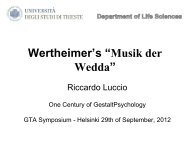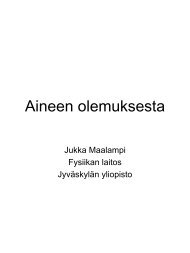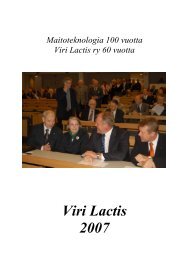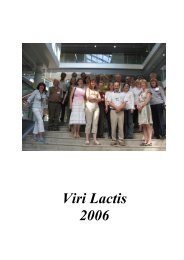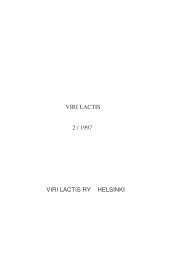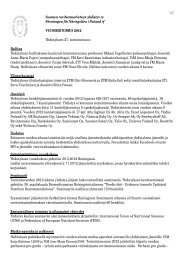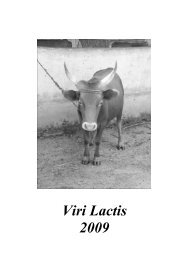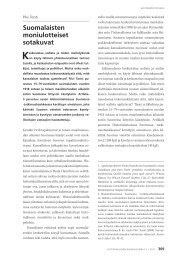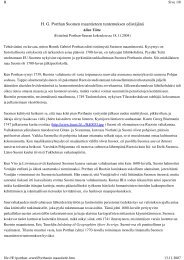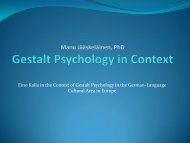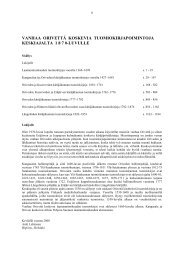Tarja Kallio-Tamminen
Tarja Kallio-Tamminen
Tarja Kallio-Tamminen
Create successful ePaper yourself
Turn your PDF publications into a flip-book with our unique Google optimized e-Paper software.
<strong>Tarja</strong> <strong>Kallio</strong>‐<strong>Tamminen</strong><br />
www.physicsfoundations.org
Picture of reality<br />
Defines the background for human existence<br />
where we are, what can be done<br />
The main features of an accustomed paradigm last long
Picture of reality<br />
Defines the background for human existence<br />
where we live, what can be done<br />
The main features of an accustomed paradigm last long<br />
Three deep revolutions in western culture<br />
Antiquity, the turn of modern era, now<br />
Fundamental metaphysical presuppositions are in change
Picture of reality<br />
Defines the background for human existence<br />
where we are, what can be done<br />
The main features of an accustomed paradigm last long<br />
Three deep revolutions in western culture<br />
Antiquity, the turn of modern era, now<br />
Fundamental metaphysical presuppositions are in change<br />
The historical process is guided by natural<br />
science and philosophy<br />
Both are important for understanding the nature of reality
Antiquity: Reality is comparable to an organism<br />
‐the whole includes a soul and is able to regulate itself<br />
‐the constitution of the whole is reflected in humans
Reality consist of matter in motion<br />
‐you cannot find a soul<br />
Reality is comparable to a clockwork<br />
mechanical, quantitative, and without purpose
Modern physics collapsed the<br />
common world view<br />
Theory of relativity<br />
connected time and<br />
space<br />
Body’s velocity, length<br />
or kinetic energy are<br />
not invariant properties<br />
but depend on the<br />
frame<br />
Quantum phenomena<br />
are impossible to<br />
understand<br />
wave-particle dualism,<br />
entanglement,<br />
statistical predictions,<br />
measurement problem<br />
…
Good bye atomism, reductionism, determinism,<br />
locality, detached external observer…
What is the basic stuff everything is made of?<br />
What is the relation between the parts and the whole?<br />
What is the role and locus of humans?
Theories are human constructions.<br />
-they contain unobservable terms<br />
-their truth can be falsified but never conclusively verified<br />
Logic and mathematics are indispensable tools but they do not<br />
straightforwardly lead to valid theories.<br />
-and theories cannot be understood without a conceptual interpretation<br />
Quest for genuine natural philosophy,<br />
empirical metaphysics
the growth in physical understanding of reality has<br />
characteristically been related to achieving a proper<br />
conceptual change, a new perspective.<br />
‐clarification of the basic principles and notions leads to<br />
further knowledge on the interrelations between the relevant<br />
concepts like substance, energy, motion and space.<br />
‐discovery of more fundamental invariances and interconnections<br />
entail that a wider variety of phenomena can be treated by one<br />
and the same mathematical formalism.
A proper view into nature most probably demands a<br />
framework unifying the quantum theory and the theory<br />
of relativity.<br />
‐ a suitable formalism cannot start from the existing<br />
(incompatible) principles but demands a new perspective<br />
Valid alternative theories are essential in providing<br />
solid material for further metaphysical inquiry
Arto Annila:<br />
The least action<br />
formalism<br />
Tuomo Suntola:<br />
The Dynamic<br />
universe<br />
Common for both:<br />
Natural evolution is included<br />
The parts are governed by the whole<br />
Stable systems are resonance structures<br />
Room for autonomous humans
Statistical mechanics of open systems<br />
‐adds the idea of open evolution to the present postulates (QM,RT)<br />
Everything consist of energy naturally dispersing from higher<br />
densities to lower ones by using the steepest available paths.<br />
‐closed and open actions, mass converts into energy in radiation<br />
Explains quantum phenomena<br />
Treatise of measurement problem comparable to Bohr’s ideas<br />
Compatible with complex systems
A covering new framework with a minimal amount of postulates.<br />
Reveals an unexpected link between mass, energy, motion and<br />
space.<br />
‐ mass is a fundamental invariant which links everything together into<br />
a holistic composition<br />
‐ localized objects are described in terms of resonant mass‐wave<br />
structures<br />
Re‐establishes the universal frame of reference<br />
Gives a comprehensible model of the constitution and evolution of<br />
the universe.<br />
Covers correctly relative, cosmological and quantum phenomena
Comparison of some<br />
metaphysical implications<br />
Basic stuff<br />
Stable structures<br />
Cause of evolution<br />
Space and time<br />
Lawfulness based on<br />
LA DU<br />
Energy exhibited<br />
in actions<br />
Closed actions<br />
Dispersion of energy<br />
(inside 3D)<br />
Generated by closed and<br />
open actions<br />
Maupertuis’ principle of<br />
least action<br />
Mass excited by<br />
energy<br />
Resonate mass<br />
waves<br />
Evolving 4‐sphere<br />
(causes 3D manifestation)<br />
Coordinate quantities<br />
Zero‐energy<br />
principle
The universe seems to be an active, hierarchically<br />
leveled whole containing systems within systems.<br />
(reminiscent to an organism rather than a clockwork)<br />
The configuration leaves room for causally active humans<br />
who nevertheless always remain subordinate to the<br />
balanced action of the whole.<br />
Thank you!



